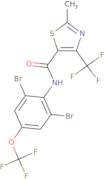Greatam
CAS: 130000-40-7
Rif. 3D-FG103442
| 25mg | Fuori produzione | ||
| 50mg | Fuori produzione | ||
| 100mg | Fuori produzione | ||
| 250mg | Fuori produzione | ||
| 500mg | Fuori produzione |
Informazioni sul prodotto
- 2',6'-Diobromo-2-Methyl-4'-Trifluoromethyox-4-Trifluoromethyl-1,3-Thiazole-5-Carboxanilide
- 2′,6′-Dibromo-2-methyl-4′-trifluoromethoxy-4-trifluoromethyl-1,3-thiazole-5-carboxyanilide
- 5-Thiazolecarboxamide, N-[2,6-dibromo-4-(trifluoromethoxy)phenyl]-2-methyl-4-(trifluoromethyl)-
- Granual
- Mon 2400
- Mon 24000
- Mon24000
- N-[2,6-Dibromo-4-(trifluoromethoxy)phenyl]-2-methyl-4-(trifluoromethyl)-5-thiazolecarboxamide
- N-[2,6-dibromo-4-(trifluoromethoxy)phenyl]-2-methyl-4-(trifluoromethyl)-1,3-thiazole-5-carboxamide
- Pulsor
- Vedi altri sinonimi
- Rh 130753
- Thifluzamide (Bsi,Iso,Ansi)
- Thifluzamide Standard
- Trifluzamide
Greatam is an organic compound that belongs to the glycol ether class. It is a white, crystalline solid with a melting point of 77 °C and a boiling point of 220 °C. Greatam has been shown to have a matrix effect on polyclonal antibodies, which may be due to its ability to increase the solubility of the antigen or antibody. The matrix effect also increases the sensitivity and specificity in analytical methods such as ELISA and Western blotting. This product inhibits the growth of resistant mutants of fungi, such as tebuconazole-resistant strains of Penicillium spp., by synergistic effects. Greatam also has an effect on hepatic lipase and solanum tuberosum enzyme activities, suggesting that it may have potential uses in reducing fat absorption in humans.





